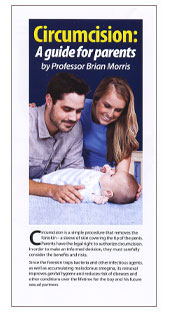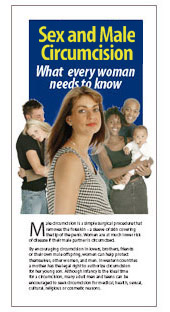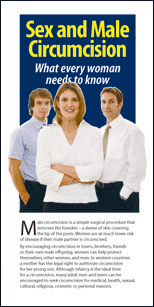Circumcision Procedure - Cost
Circumcision is amongst the 40 most frequently performed surgical procedures, occurring more commonly than tooth extraction [Australia's, 1992].
In the USA cost per newborn is typically $165 [Schoen et al., 2006]. Post-neonatal circumcision, however, is approx. 10 times more expensive [Schoen et al., 2006]. The total cost of newborn circumcisions in the USA is estimated as US$150–270 million.
In Australia, in the year to Feb 2004, 16,311 neonatal circumcisions were performed at a cost to Medicare of A$623,080. Interestingly, as an important historical anecdote, back in 1985 the Federal Minister for Health removed the rebate for newborn circumcision from the Medical Benefits Schedule in response to the (now outmoded) 1983 recommendations of the National Health & Medical Research Council (NHMRC) of Australia. It was then quickly restored after a public outcry. The NHMRC currently has no policy statement on circumcision.
The scheduled fee for a neonatal circumcision in Australia in 2004 was A$38.20 (~US$26) [Australian, 2004b]. The overall cost to Medicare for circumcisions in the year to Feb 2004 was thus A$623,080 + $275,210 + ($298,880 or $369,086) = $928,170-998,375.
In 2007 the scheduled fee in Australia was A$42.00, with a benefit of A$35.70 [Medicare, 2007b]. For circumcision of those aged 0.5–10 years the scheduled fee was A$97.65 and benefit A$83.05. For circumcisions in those over age 10 these figures were A$135.20 and A$114.95, respectively, (if done by a general practitioner) and A$167.65 and A$142.55 (if done by a specialist).
In late 2009, the scheduled fee for a male under 6 months of age was A$43.95, with the Medicare benefit being A$37.40 (85%) or A$33.00 (75%) [Government, 2009] (http://www9.health.gov.au/mbs/search.cfm?q=30653-30660&sopt=I). For 0.5-10 years the scheduled fee was A$102.20 and benefit A$86.90 (85%) or A$76.65 (75%). The general practitioner fee for males 10 and over was A$141.50 and the benefit A$120.30 (85%) or A$106.15 (75%). For a specialist the scheduled fee was A$175.45 and benefit A$149.15 (85%) or A$131.60 (75%).
In the years that have followed the schedules fee and rebate have changed little, but the amount actually charged by private medical practitioners has increased substantially. A likely reason is that elective circumcisions are no longer available in the public hospital system.
Many doctors consider that the scheduled fee and thus benefit in Australia should be higher, as such a low rebate has the potential to cause some doctors to discourage circumcision because of the low return relative to other procedures.
In the USA, a neonatal circumcision will generally cost US$89–204, being cheaper in the mid-west and more expensive on the east coast. A review in 1995 found that 61% of infant circumcisions were paid for by private insurance, 36% by Medicaid, and 3% were paid for by the parents [Mansfield et al., 1995]. From 1999 to 2007, of the 52 states in the USA, 16 had ceased to allow Medicaid payments for circumcisions other than for those needed to treat a medical condition [National, 2006b]. As a result, circumcision rate, especially amongst the poor, has gone down in those states, and will have a devastating effect on public health [Leibowitz et al., 2009; Morris et al., 2009]. Such short-sighted policy, which would save money in the short term (but not the long term), has followed intense lobbying by anti-circumcision organizations. The devastating impact the latter extremists having on gullible politicians is to be deplored.
The ensuing decrease in infant MC in the USA has been estimated to result in >100 additional HIV cases and $30M in net medical costs for treatment per year [Andrews et al., 2012]. The cost to circumcise males in that birth cohort was US$4,856,000, i.e., 6% of the cost of treating just HIV. Modelling studies have, moreover, found cost savings initially generated by non-coverage of elective infant MC by Medicaid in Louisiana [Ortenberg & Roth, 2013] and Florida [Gutwein et al., 2013] were mitigated by increases in rate and expense of medically indicated MC. The Louisiana study only considered the costs of later MC for boys aged 0–5 years. Lifetime costs would therefore represent a far greater financial burden on healthcare systems. The Florida study found Medicaid defunding led to a 6-fold rise in publicly funded MCs at a cost of US$112M [Gutwein et al., 2013], leading Florida to restore Medicaid coverage for non-medical MC [Attorneys 2014]. It is possible that Colorado may have also restored Medicaid coverage.
Similar nonsense has seen governments in all states and territories of Australia from 2006 onwards exclude circumcisions, except for “medical need”, in the public hospital system, classing them as “social” or “cosmetic” procedures along with breast implants, tattoo removal, liposuction and reversal of sterilization. The Ministers for Health suggest circumcision be sourced in the private sector, failing to recognize any of the health benefits. Quite surprising is that the governments that made these decisions were of the Labor (socialist) party, meaning that the poor in society, who are usually more likely to be protected by Labor party policies and who rely on the public hospital system, are the ones now most adversely affected.
Clearly common sense and the application of evidence-based medicine to circumcision policy is needed in the public health system.



